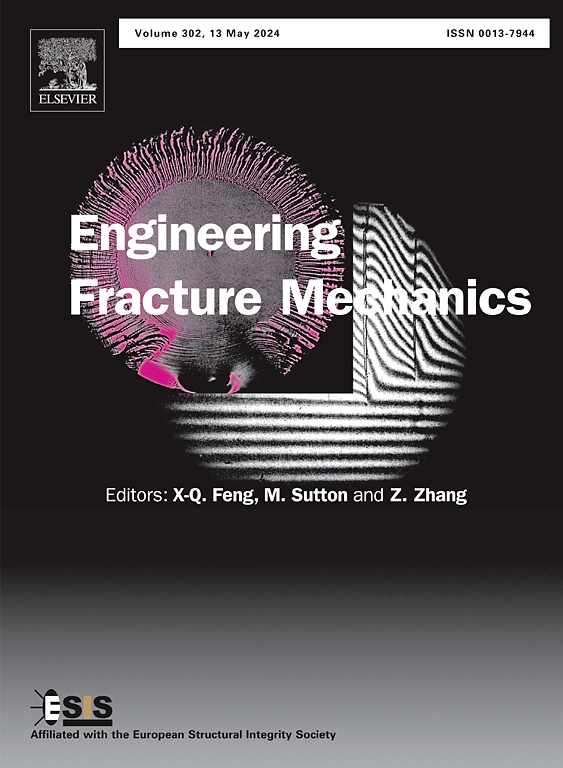Fragmentation characteristics and energy components of non-cylindrical rock specimens in a novel collision system
IF 4.7
2区 工程技术
Q1 MECHANICS
引用次数: 0
Abstract
This paper presents the results of rock fragmentation by using a new collision method we reported earlier. Since the method has been proved to be successful for cylindrical rock specimens in our earlier papers, this paper presents the results from 28 non-cylindrical rock specimens such as half-cylinders and half-discs. The results show that: (1) all rock specimens were successfully released at a flight velocity of 13.7 – 62.5 m/s, validated the method for non-cylindrical specimens. (2) All specimens were broken into various sizes of fragments (particles). (3) The energy transferred to the transmitted bar was in a range of 0.3 – 3.4 % of input energy. (4) The translational kinetic energy of rock specimen was in a range of 0.1 – 18.9 % of input energy, while the rotational kinetic energy of rock specimen was 3.3 –5.1 % of input energy. (6) The specific input energy (input energy per unit volume of rock) varied from 0.26 to 5.06 MJ/m3. (7) The main factors influencing rock fragmentation include specific input energy, rock impedance and foliations. Larger specific input energy or smaller impedance resulted in better fragmentation, and vice versa. Foliations, especially parallel ones, made spalling occurred in most quartzite specimens as well as a few other rock specimens before they collided with the transmitted bar. Assuming that relative energy efficiency is equal to the ratio of the energy absorbed by rock to the input energy, the paper finds that the relative energy efficiency of the rock collision method is much higher than the relative energy efficiencies of dynamic rock compression, dynamic rock fracture, and ore grinding in ball mills, indicating a great potential of applying the collision method to mining industry.
一种新型碰撞系统中非圆柱形岩石试样的破碎特性和能量分量
本文介绍了我们以前报道过的一种新的碰撞方法对岩石破碎的结果。由于该方法在我们之前的文章中已被证明是成功的圆柱形岩石样品,本文介绍了28个非圆柱形岩石样品(如半圆柱形和半圆盘形)的结果。结果表明:(1)所有岩石试样均以13.7 ~ 62.5 m/s的飞行速度成功释放,验证了该方法对非圆柱形试样的有效性。(2)所有试样均被破碎成大小不等的碎片(颗粒)。(3)传递给传输棒的能量为输入能量的0.3% ~ 3.4%。(4)岩石试样的平移动能为输入能量的0.1 ~ 18.9%,旋转动能为输入能量的3.3 ~ 5.1%。(6)比输入能量(单位体积岩石的输入能量)在0.26 ~ 5.06 MJ/m3之间变化。(7)影响岩石破碎的主要因素包括比输入能量、岩石阻抗和片理。输入比能量越大,阻抗越小,碎片化效果越好,反之亦然。叶理作用,尤其是平行叶理作用,使大多数石英岩标本以及少数其他岩石标本在与透射砂块碰撞之前发生剥落。假设相对能量效率等于岩石吸收的能量与输入能量之比,本文发现岩石碰撞法的相对能量效率远高于岩石动态压缩、岩石动态破碎和球磨机磨矿的相对能量效率,表明碰撞法在采矿业中的应用潜力巨大。
本文章由计算机程序翻译,如有差异,请以英文原文为准。
求助全文
约1分钟内获得全文
求助全文
来源期刊
CiteScore
8.70
自引率
13.00%
发文量
606
审稿时长
74 days
期刊介绍:
EFM covers a broad range of topics in fracture mechanics to be of interest and use to both researchers and practitioners. Contributions are welcome which address the fracture behavior of conventional engineering material systems as well as newly emerging material systems. Contributions on developments in the areas of mechanics and materials science strongly related to fracture mechanics are also welcome. Papers on fatigue are welcome if they treat the fatigue process using the methods of fracture mechanics.

 求助内容:
求助内容: 应助结果提醒方式:
应助结果提醒方式:


